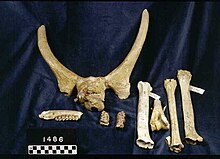
Ruminants are herbivorous grazing or browsing artiodactyls belonging to the suborder Ruminantia that are able to acquire nutrients from plant-based food by fermenting it in a specialized stomach prior to digestion, principally through microbial actions. The process, which takes place in the front part of the digestive system and therefore is called foregut fermentation, typically requires the fermented ingesta to be regurgitated and chewed again. The process of rechewing the cud to further break down plant matter and stimulate digestion is called rumination. The word "ruminant" comes from the Latin ruminare, which means "to chew over again".

Tylopoda is a suborder of terrestrial herbivorous even-toed ungulates belonging to the order Artiodactyla. They are found in the wild in their native ranges of South America and Asia, while Australian feral camels are introduced. The group has a long fossil history in North America and Eurasia. Tylopoda appeared during the Eocene around 50 million years ago.
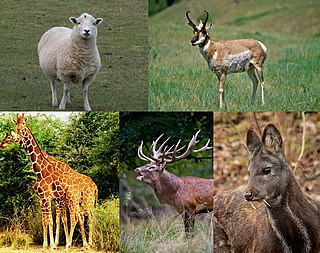
Pecora is an infraorder of even-toed hoofed mammals with ruminant digestion. Most members of Pecora have cranial appendages projecting from their frontal bones; only two extant genera lack them, Hydropotes and Moschus. The name "Pecora" comes from the Latin word pecus, which means "cattle". Although most pecorans have cranial appendages, only some of these are properly called "horns", and many scientists agree that these appendages did not arise from a common ancestor, but instead evolved independently on at least two occasions. Likewise, while Pecora as a group is supported by both molecular and morphological studies, morphological support for interrelationships between pecoran families is disputed.

Archaeotherium is an extinct genus of entelodont artiodactyl endemic to North America during the Eocene and Oligocene epochs. Archaeotherium fossils are most common in the White River Formation of the Great Plains, but it has also been found in the John Day Basin of Oregon and the Trans-Pecos area of Texas.

Ferungulata is a grandorder of placental mammals that groups together mirorder Ferae and clade Pan-Euungulata. It has existed in two guises, a traditional one based on morphological analysis and a revised one taking into account more recent molecular analyses. The Fereungulata is a sister group to the order Chiroptera (bats) and together they make clade Scrotifera.

The John Day Formation is a series of rock strata exposed in the Picture Gorge district of the John Day River basin and elsewhere in north-central Oregon in the United States. The Picture Gorge exposure lies east of the Blue Mountain uplift, which cuts southwest–northeast through the Horse Heaven mining district northeast of Madras. Aside from the Picture Gorge district, which defines the type, the formation is visible on the surface in two other areas: another exposure is in the Warm Springs district west of the uplift, between it and the Cascade Range, and the third is along the south side of the Ochoco Mountains. All three exposures, consisting mainly of tuffaceous sediments and pyroclastic rock rich in silica, lie unconformably between the older rocks of the Clarno Formation below and Columbia River basalts above.
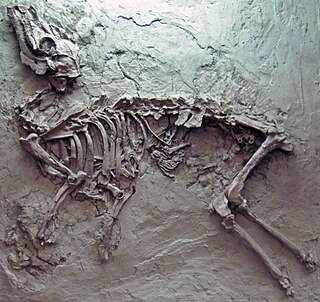
Pseudoprotoceras is an extinct genus of Artiodactyla, of the family Protoceratidae, endemic to central North America. It lived during the Late Eocene 37.2—33.9 Ma, existing for approximately 3 million years. Pseudoprotoceras resembled hornless deer, but were more closely related to camelids.
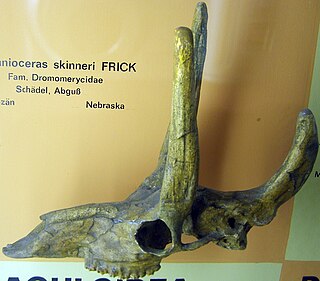
The Dromomerycidae is an extinct family of Neogene ruminants belonging to the infraorder Pecora. Dromomerycids, known by two subfamilies, were endemic to North America from the later early Miocene up to the early Pliocene, leaving no descendants. Dromomerycidae has a long history of uncertain taxonomic affiliations due to its superficial resemblances with the Eurasian Neogene Palaeomerycidae and were traditionally classified as subfamilies within the family. However, recent research differentiates the dromomerycids from the Giraffomorpha by the lack of sutures on the skull roof that typically make up the ossicones of the later clade. The similar resemblances of the appendages therefore could be the result of parallel evolution.

Camelinae is a subfamily of artiodactyls of the family Camelidae. Camelinae include the tribes Camelini and Lamini. A third tribe, Camelopini, created by S. D. Webb (1965), was formerly included, but was discarded by J. A. Harrison (1979) after it was shown to be polyphyletic: it consisted of the genera Camelops and Megatylopus, which were moved to Camelini and Lamini respectively.

Anoplotheriidae is an extinct family of artiodactyl ungulates. They were endemic to Europe during the Eocene and Oligocene epochs about 44—30 million years ago. Its name is derived from the Ancient Greek: ἂνοπλος ("unarmed") and θήριον ("beast"), translating as "unarmed beast".

Palaeomeryx is an extinct genus of Artiodactyla, of the family Palaeomerycidae, endemic to Europe and Asia from the Miocene epoch, 16.9 – 7.25 Ma, existing for approximately 9.65 million years.
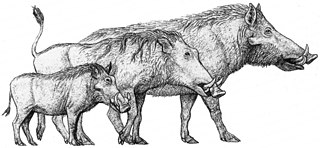
Notochoerus is an extinct genus of very large pigs from the subfamily Tetraconodontinae. Fossils have been found in Africa, notably Uganda and Ethiopia.

Chleuastochoerus is an extinct genus in the pig family that lived in the Miocene and Pliocene in Russia and Eastern Asia.

Subdromomeryx is an extinct genus of Artiodactyla, of the family Palaeomerycidae, endemic to North America.
Togocetus is a genus of extinct cetacean from the Lutetian of Togo, known from a fossilized skeleton discovered a few kilometers north-east of Lomé.
Proentelodon is an extinct genus of entelodont artiodactyl from the Middle Eocene of Mongolia. P. minutus is the oldest representative of the family Entelodontidae, P. minutus gen. et sp. nov, is described from the Middle Eocene Khaichin Ula II Fauna in Mongolia. The placement of the genus in the entelodonts has been questioned by other authors, but its placement as related to the group has been supported by some cladistic analyses.
Gagadon is an extinct genus of even-toed ungulate that lived in the early Eocene of North America. The type and only known species, Gagadon minimonstrum, was described in 2014 based on lower teeth and jaw fragments found in the Wasatch Formation of Bitter Creek, Wyoming. The genus is named in honor of the singer Lady Gaga, while the species name minimonstrum refers to the small size and presence of unusual cusps on the teeth.
Shirley Cameron Coryndon (1926–1976) was a British paleontologist and authority on fossil hippopotami.
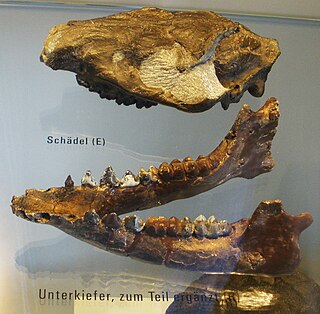
Microbunodon was a genus of extinct artiodactyl mammals in the family Anthracotheriidae. It lived between the upper Eocene and the lower Pliocene. Its fossil remains have been found in Europe and Asia.
Rhinoclemmys panamaensis is an extinct species of turtle belonging to the genus Rhinoclemmys of the family Geoemydidae known from the early to middle Miocene (Hemingfordian) Cucaracha Formation of the Panama Basin of central Panama.
